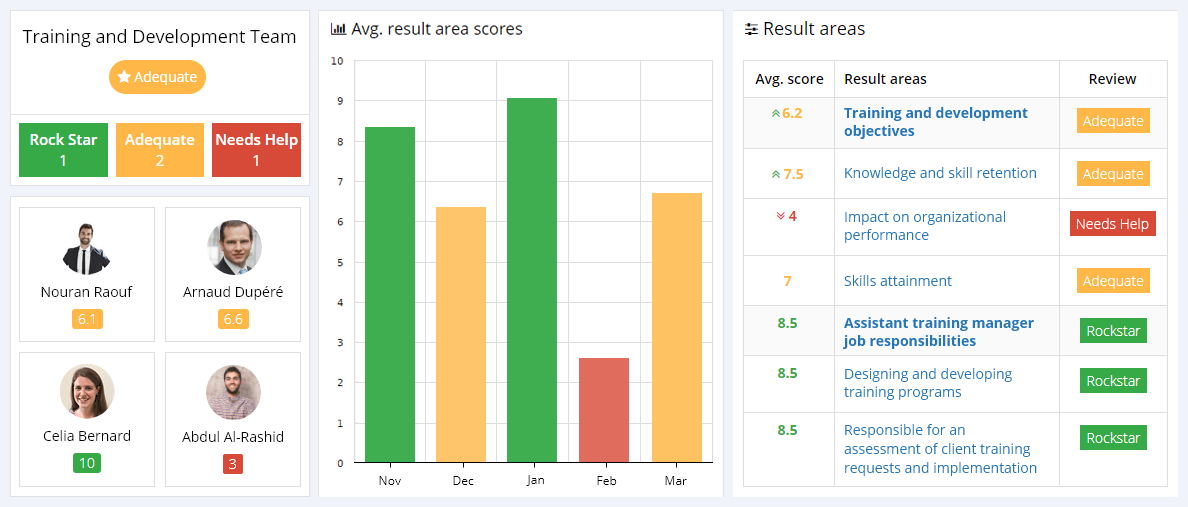Training and Development Objectives
Training and Development Objectives (KPIs) are designed to measure the impact your company’s training and development program has on your employees. These objectives measure whether employees are engaging with it and benefiting from it. A well-run program will be of immense benefit to the employees and the company.
- Time to proficiency – Time to proficiency measures the time it takes for employees to grasp the outcomes of the training. The faster employees learn, the sooner they will produce results. Consequently, this metric is an indicator of training effectiveness.
- Knowledge and skill retention – The knowledge and skill retention KPI is designed to measure the extent to which employees retain the knowledge and skills gained during the training sessions. It also measures the employees’ improvement in expertise and their ability to apply the knowledge gained directly to their work functions.
View all
- Transfer of training – The transfer of training KPI is designed to measure the extent to which employees are able to transform knowledge gained during a training program into skill. The fundamental objective of corporate training is to enable employees to turn their knowledge into expertise.
- Impact on organizational performance – The impact on organizational performance measures the difference in employee performance before and after training. Training improves business efficiencies, productivity, and ensures that the company meets its compliance requirements. Succinctly stated, training is the key to improving the performance of both individual employees and the organization.
- Employee engagement – Employee engagement measures the extent to which employees engage with the training program to turn the knowledge gained into usable skills. The more employees engage with the training and development program, the higher their skill levels are, and the greater the chance that the organization will meet its goals.
- Stakeholder satisfaction – The stakeholder satisfaction KPI measures how satisfied the clients are with the training and development program. This metric is evaluated based on employee learning outcomes. If the client sees the value in the training program, the stakeholder satisfaction value will be high.
- Increased retention – The increased retention KPI measures how long employees remain with a company. If newly trained employees feel ill-equipped for the job, they are more likely to leave within their first 90 days. When training success is measured in terms of employee retention, higher retention points to a successful training program.
- Skills attainment – The skill attainment KPI measures the employee’s level of knowledge or skill pre-learning and again post learning. If the employee’s skill level has not improved post-training, the training program was not successful.
- Workplace application – The workplace application KPI is designed to measure whether there is evidence of the employee applying the newly learned skill or knowledge gain in the workplace.
- Individual behavior change – The individual behavior change KPI measures whether the employee’s behavior has changed due to a training and development program reflecting the corporate culture and goals.
- Team behavior change – The team behavior change KPI is designed to measure whether the team is working together more coherently and more effectively after attending a training program.
- Meeting goals or targets – The meeting goals or targets post-training KPI measures the individual employee or team performance against predefined goals or targets. This metric is tracked over time (3, 6, and 9 months) post learning to monitor the impact of the training program.
- Cost of training – The cost of training KPI measures the cost of a training program per attendee. This is an internal training department measurement. In high turnover organizations, lowering the cost per student of training per employee or attendee can be used as an effectiveness measurement.
- Revenue generation – The revenue generation KPI measures the company revenue generated as a direct and indirect consequence of employee training. If the organization shows an increase in revenue after the training program, it is due to the training. A new income generation venture is the best time to measure this KPI.
- Instructor performance – The instructor performance metric measures how well the instructor has performed during the training. Aspects evaluated include the instructor’s presentation skills, knowledge of the subject, projection of organizational values, and adherence to instructional guidelines. Both employees or trainees can assess the instructor.
- End-user satisfaction – End-user satisfaction measures the effectiveness of the training program. The training’s effectiveness can be tracked straight after the training has ended, then 30 and 60 days afterward.
View less
Assistant Training Manager Job Responsibilities
- Analyze customer satisfaction reports and quality reports periodically to identify the training needs.
- Designing and developing training programs.
View all
- Develop and deliver training on account of issues/areas recommended by the Client in e-mails/conference calls.
- Drive design, development, and delivery of all ongoing, new-hire, re-training, and other programs and allocating resources required for the same.
- Evaluate/Analyze and identify training needs to meet account/program objectives.
- Monitor and control all account-related training activities (planning and execution) on the site by the trainers.
- Planning and assessment of training programs.
- Provide timely feedback on all account training and instructional design to the trainers.
- Research and experiment of new processes/systems to improve training function.
- Responsible for an assessment of client training requests and implementation.
- Review and monitor all account training activities by trainers.
- Review existing New Hire Certification/re-certification/quizzing processes frequently and measure effectiveness.
- To participate in all relevant client calls and take the learning forward in training module development.
- Training Feedback Analysis for continual improvement in training function.
View less
Training and Development Officer Job Responsibilities
- Assist in the review and development of policies and procedures as and when required.
- Coordinate with HR for employee inductions, including review and development to ensure the accuracy and relevance of the program.
View all
- Demonstrate a positive attitude and continuous improvement methodology across all aspects of this role.
- Design, coordinate and deliver internal training programs in consultation with the People and Performance Manager and/or departmental managers.
- Develop training support documentation as required.
- Ensure all work is carried out in a professional and safe manner.
- Ensure the accurate and timely implementation and maintenance of training records in consultation with other Human Resources personnel.
- In consultation with the People and Performance, the Manager recommends and coordinates the provision of specialized external training as required.
- Participate in external audits as and when required.
- Participate in the development, review, and monitoring of the Annual Training Matrix.
View less
Training Coordinator Job Responsibilities
- Conduct training assessments and identify skills or knowledge gaps that need to be addressed.
- Design and develop training programs (outsourced and/or in-house).
View all
- Design, prepare and order educational aids and materials.
- Maintain updated curriculum database and training records.
- Map out annual training plans for management, HR, customer support and more.
- Market available training to employees and provide necessary information about sessions.
- Select appropriate training methods or activities (e.g. simulations, mentoring, on-the-job training, professional development classes).
- Use known education principles and stay up-to-date on new training methods and techniques.
View less
Teaching Assistant Job Responsibilities
- Attending meetings and trainings.
- Communication with administration and/or supervisors.
View all
- Discipline referrals.
- Emails to students and/or parents.
- Emergency alerts.
- Engaging with students and/or parents through the messaging platform.
- Managing time.
- Meeting deadlines.
- Minimal assistance.
- Office hours.
- Setting up environment for beginning of term in the messaging platform.
- Timeclock responsible.
View less
Training and development is a core function of the organization, irrespective of its size. Key Performance Indicators or KPIs for the training and development department, including real-time tracking, are intended to measure the optimal functioning of staff employed by the organization. Essentially, the organization cannot flourish without high-functioning employees.
Therefore, the key performance areas that must be measured include the identification of individual training and development needs, ensure that the stated training meets its desired outcomes, review the company’s training and development policies and methodologies, research, design and develop training programs, and manage external training facilitators and development programs.

